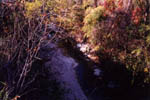 |
The park had previously been a part of the Gracy family farm, so it is still
a relatively young woodland, with lots of undergrowth and immature trees.
The trails are popular with hikers and mountain bikers alike.
|
 |
Some wildflowers growing along the trail. Central Texas really has two growing
seasons separate by the heat of August. Quite a lot of vegetation comes
roaring back to life in the cooler fall temperatures.
|
 |
One of the branches of Walnut Creek, about fifteen feet below at the bottom
of a small cliff. Some of the tree leaves are actually showing fall colors,
which happens some years when the rainfall and temperatures have been just
right.
|
 |
Some more wildflowers in the tall grass by the trail. There are several
meadows in the park, filled with tall grass and prickly pear cactus.
|
 |
A riot of undergrowth vegetation, including these purple wildflowers.
|
 |
A hint of what a more mature woodland could look like, with sparser
undergrowth and cedar trees dominated by taller deciduous trees.
|
 |
Another bunch of those purple flowers.
|
 |
A view of the creek. Walnut Creek usually has flowing water in it year-round,
but in drought years it can run dry.
|
 |
The trails cross the various branches of Walnut Creek several at several
places.
|
 |
A view down the steep bank at the creek.
|
 |
A mountain cedar tree. These trees, also known as the scrub juniper, once
grew only near creeks like Walnut Creek - above the creek beds, natural
wildfires kept them from spreading. Today, with settlement and wildfire
suppression, cedars have taken over what had traditionally been prairie
grasslands, and consume far more water than the species of plants they
replaced.
|
 |
Some trees showing a hint of fall colors - nothing like what happens in
New England, of course, but fall colors in Texas are kind of special.
|
 |
One of the main trails in the park. There are some large, double-track trails
in the park that form a couple of big loops, popular with joggers and the less
adventurous mountain bikers.
|
 |
The trail, as it enters a small meadow. The evergreen trees on either side
of the foreground are cedars.
|
 |
A large, old cedar tree. In December and January, the cedars pollinate and
make allergy sufferers miserable. Locally, the symptoms are called "cedar
fever."
|
 |
Some vines with red berries.
|
 |
The trail goes through both open spaces and very densely overgrown spaces.
|
 |
A yucca plant growing in the tall grass.
|

















